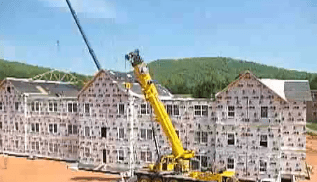
Buildings consume 40 per cent of the world’s energy. Tom O’Hara of U. S.-based modular construction company Capsys, noting the energy conservation that results from building indoors, says, “We can do a unique airflow test on each of our modules that is not possible in traditional building. We essentially suck the air out of an apartment and measure the difference between the exterior and interior. As a result our buildings are 100 per cent more airtight than required – simply because the corners are actually square and flush.” Window insulation and heat recovery systems further contribute to conservation. He adds: “Our factory is the height of sustainability, and the industry as a whole has huge potential. We fully meet LEED’s [US Green Building Council] legislation as we are very low-waste. All orders are structured and manufactured to a specific size which means few cut offs and little wasted materials. This also allows us to recycle materials such as gypsum that disintegrate in rain – traditionally if these were left exposed on a building site they would just be thrown away.”
As MHProNews.com understands, the same can be said for manufactured housing: The efficient use of resources in building leads to cost savings and sustainability for the homeowner. ##
(Photo credit: Mod-U-Kraf–modular dormitory at Ferrum College in Virginia)

























